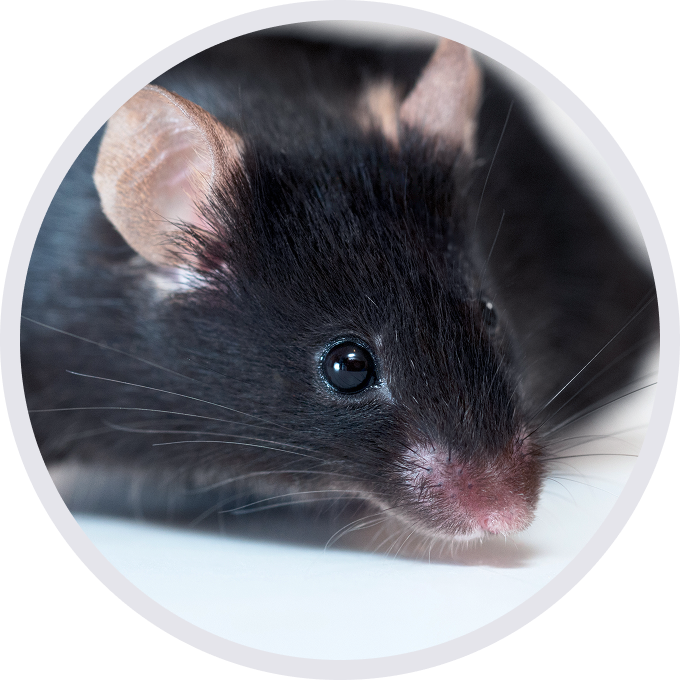
C57BL/6-B2mtm2(B2M/HLA-A2.1/H2-D)Bcgen H2-Eatm1(HLA-DRA1*1.1-I-Ea)Bcgen H2-Eb1tm1(HLA-DRB1*1.1-I-Eb1)Bcgen H2-Aatm1Bcgen H2-Ab1tm1BcgenH2-Eb2tm1Bcgen/Bcgen • 114029

| Product name | B-HLA-A2.1/HLA-DRB1*1.1 mice |
|---|---|
| Catalog number | 114029 |
| Strain name | C57BL/6-B2mtm2(B2M/HLA-A2.1/H2-D)Bcgen H2-Eatm1(HLA-DRA1*1.1-I-Ea)Bcgen H2-Eb1tm1(HLA-DRB1*1.1-I-Eb1)Bcgen H2-Aatm1Bcgen H2-Ab1tm1BcgenH2-Eb2tm1Bcgen/Bcgen |
| Strain background | C57BL/6 |
| NCBI gene ID | 567,3105,3122,3123 (Mouse) |
| Aliases | IMD43; HLAA; HLA-DRA1; SS1; DRB1; HLA-DRB; HLA-DR1B |
Gene targeting strategy for B-HLA-A2.1/HLA-DRB1*1.1 mice.
The B2m gene (Exon1 to Exon3) of mouse was replaced by the sequence encompassing the human B2M CDS and HLA-A*0201 gene that included leader sequence, α1 and α2 domains ligated to a fragment of the murine H-2Db gene containing the α3, transmembrane and cytoplasmic domains.
The exon 2 of mouse I-Ea gene that encodes the extracellular domain of I-Ea was replaced by human HLA-DRA encoding the α1 domain in B-HLA-A2.1/HLA-DRB1*1.1 mice. The exon 2 of mouse I-Eb1 gene that encodes the extracellular domain of I-Eb1 was replaced by human HLA-DRB encoding the β1 domain in B-HLA-A2.1/HLA-DRB1*1.1 mice. The mouse I-Aa, I-Ab1 and I-Eb2 were knocked out in B-HLA-A2.1/HLA-DRB1*1.1 mice.
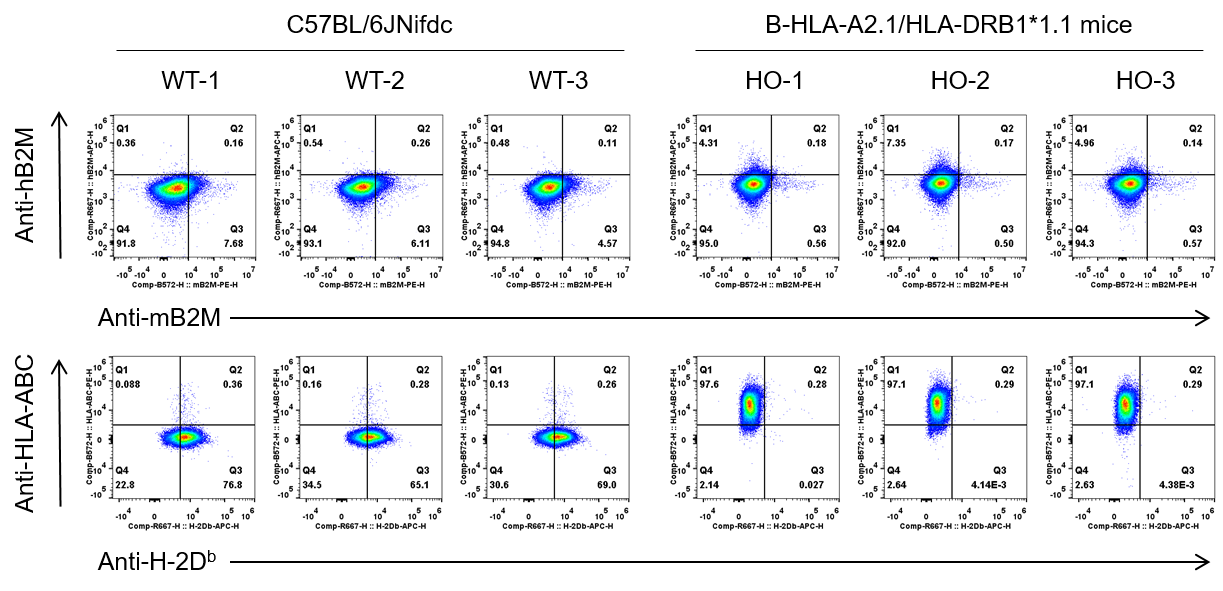
Strain specific B2M and HLA expression analysis in wild-type (WT) C57BL/6JNifdc mice and homozygous (HO) B-HLA-A2.1/HLA-DRB1*1.1 mice by flow cytometry. Splenocytes were collected from wild-type C57BL/6JNifdc mice and homozygous B-HLA-A2.1/HLA-DRB1*1.1 mice, and analyzed by flow cytometry with species-specific anti-mouse B2M antibody (BD, 744802), anti-human B2M (Biolegend, 395712), anti-mouse H-2Db (Biolegend, 111513) and anti-human HLA-ABC (Biolegend, 311406). Mouse B2M and H-2Db were only detectable in wild-type mice. Human B2M and HLA-A2.1 were exclusively detectable in homozygous B-HLA-A2.1/HLA-DRB1*1.1 mice.
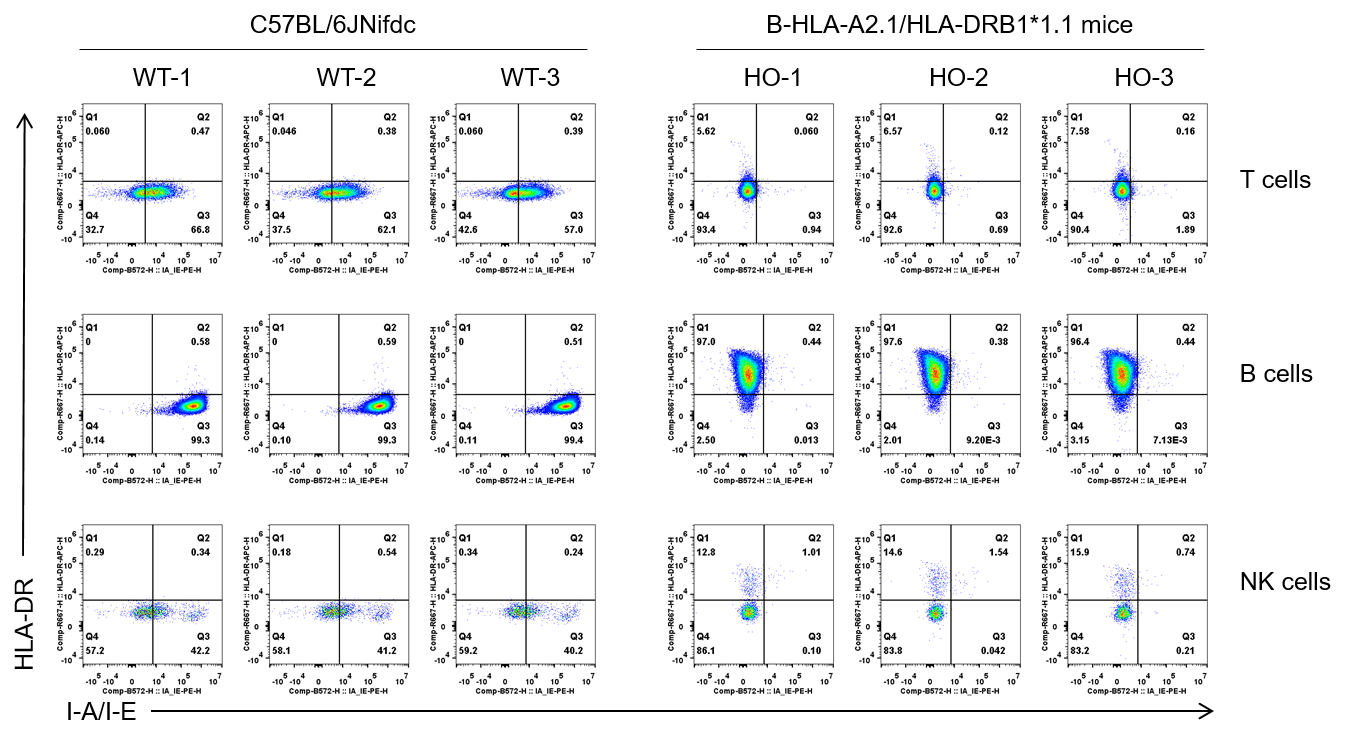
Strain specific HLA-DRB1 expression analysis in wild-type (WT) C57BL/6JNifdc mice and homozygous (HO) B-HLA-A2.1/HLA-DRB1*1.1 mice by flow cytometry. Splenocytes were collected from wild-type C57BL/6JNifdc (+/+) and homozygous humanized B-HLA-A2.1/HLA-DRB1*1.1 mice, respectively, and analyzed by flow cytometry with species-specific anti-mouse I-A/I-E antibody (Biolegend, 107607), and species-specific anti-human HLA-DR antibody (Biolegend, 307610). Human HLA-DRB1 was exclusively detectable in homozygous B-HLA-A2.1/HLA-DRB1*1.1 mice, but not in wild-type C57BL/6JNifdc mice.
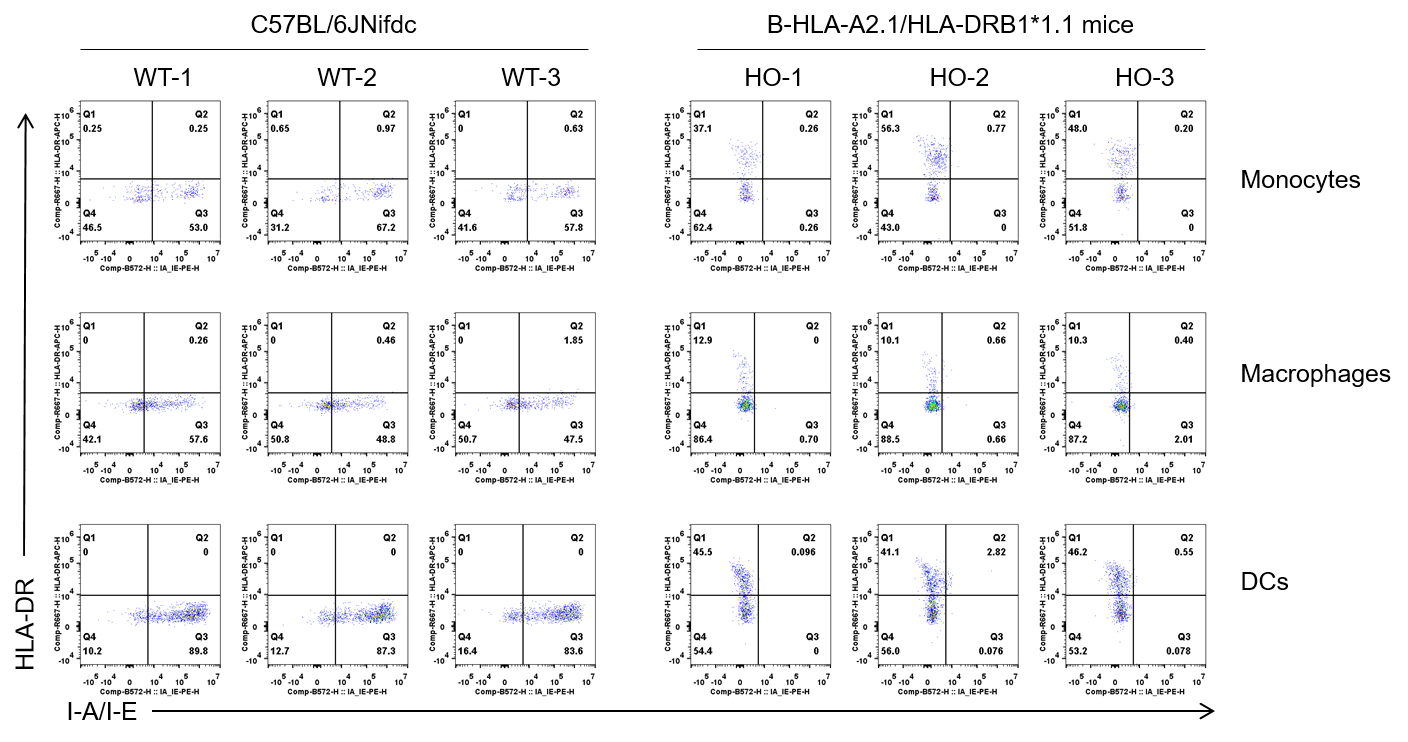
Strain specific HLA-DRB1 expression analysis in wild-type (WT) C57BL/6JNifdc mice and homozygous (HO) B-HLA-A2.1/HLA-DRB1*1.1 mice by flow cytometry. Splenocytes were collected from wild-type C57BL/6JNifdc (+/+) and homozygous humanized B-HLA-A2.1/HLA-DRB1*1.1 mice, respectively, and analyzed by flow cytometry with species-specific anti-mouse I-A/I-E antibody (Biolegend, 107607), and species-specific anti-human HLA-DR antibody (Biolegend, 307610). Human HLA-DRB1 was exclusively detectable in homozygous B-HLA-A2.1/HLA-DRB1*1.1 mice, but not in wild-type C57BL/6JNifdc mice.

Strain specific HLA-DRB1 expression analysis in wild-type (WT) C57BL/6JNifdc mice and homozygous (HO) B-HLA-A2.1/HLA-DRB1*1.1 mice by flow cytometry. Splenocytes were collected from wild-type C57BL/6JNifdc (+/+) and homozygous humanized B-HLA-A2.1/HLA-DRB1*1.1 mice, respectively, and analyzed by flow cytometry with species-specific anti-mouse I-A/I-E antibody (Biolegend, 107607), and species-specific anti-human HLA-DR antibody (Biolegend, 307610). Human HLA-DRB1 was exclusively detectable in homozygous B-HLA-A2.1/HLA-DRB1*1.1 mice, but not in wild-type C57BL/6JNifdc mice.
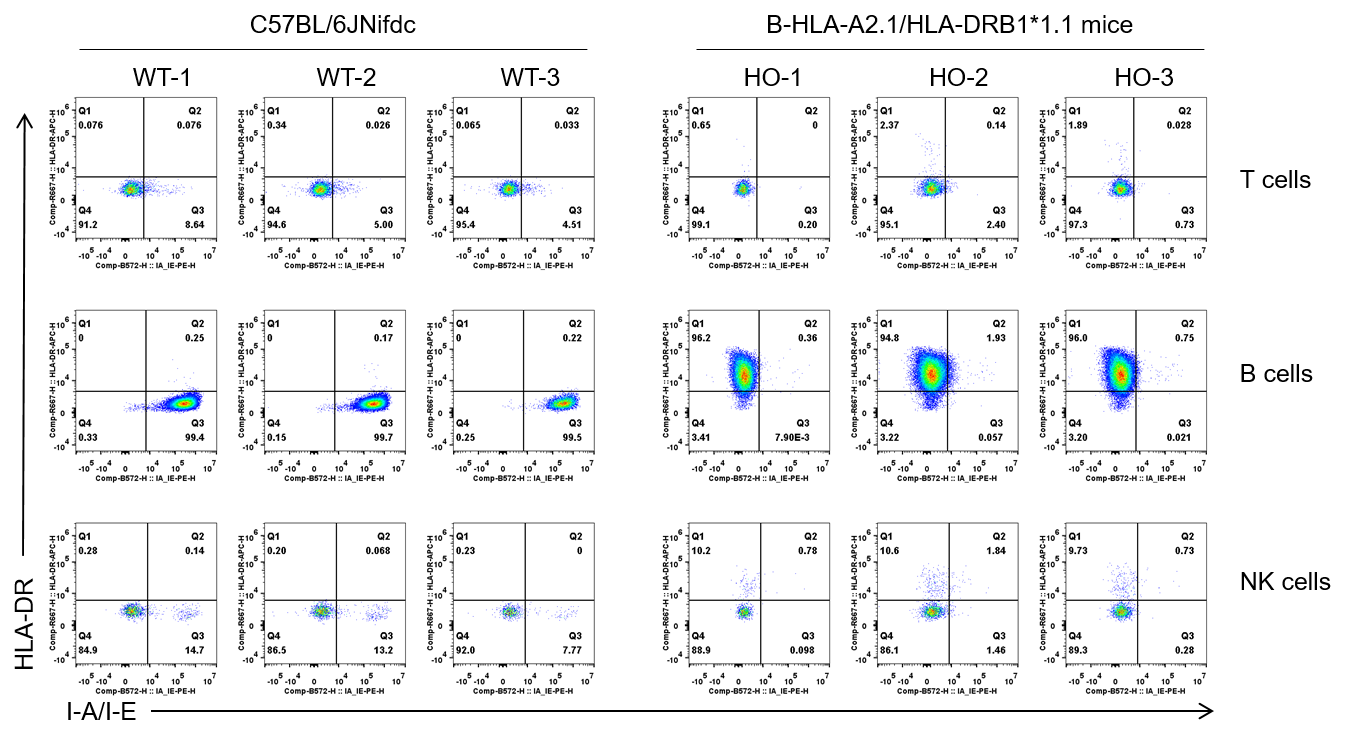
Strain specific HLA-DRB1 expression analysis in wild-type (WT) C57BL/6JNifdc mice and homozygous (HO) B-HLA-A2.1/HLA-DRB1*1.1 mice by flow cytometry. Blood cells were collected from wild-type C57BL/6JNifdc (+/+) and homozygous humanized B-HLA-A2.1/HLA-DRB1*1.1 mice, respectively, and analyzed by flow cytometry with species-specific anti-mouse I-A/I-E antibody (Biolegend, 107607), and species-specific anti-human HLA-DR antibody (Biolegend, 307610). Human HLA-DRB1 was exclusively detectable in homozygous B-HLA-A2.1/HLA-DRB1*1.1 mice, but not in wild-type C57BL/6JNifdc mice.
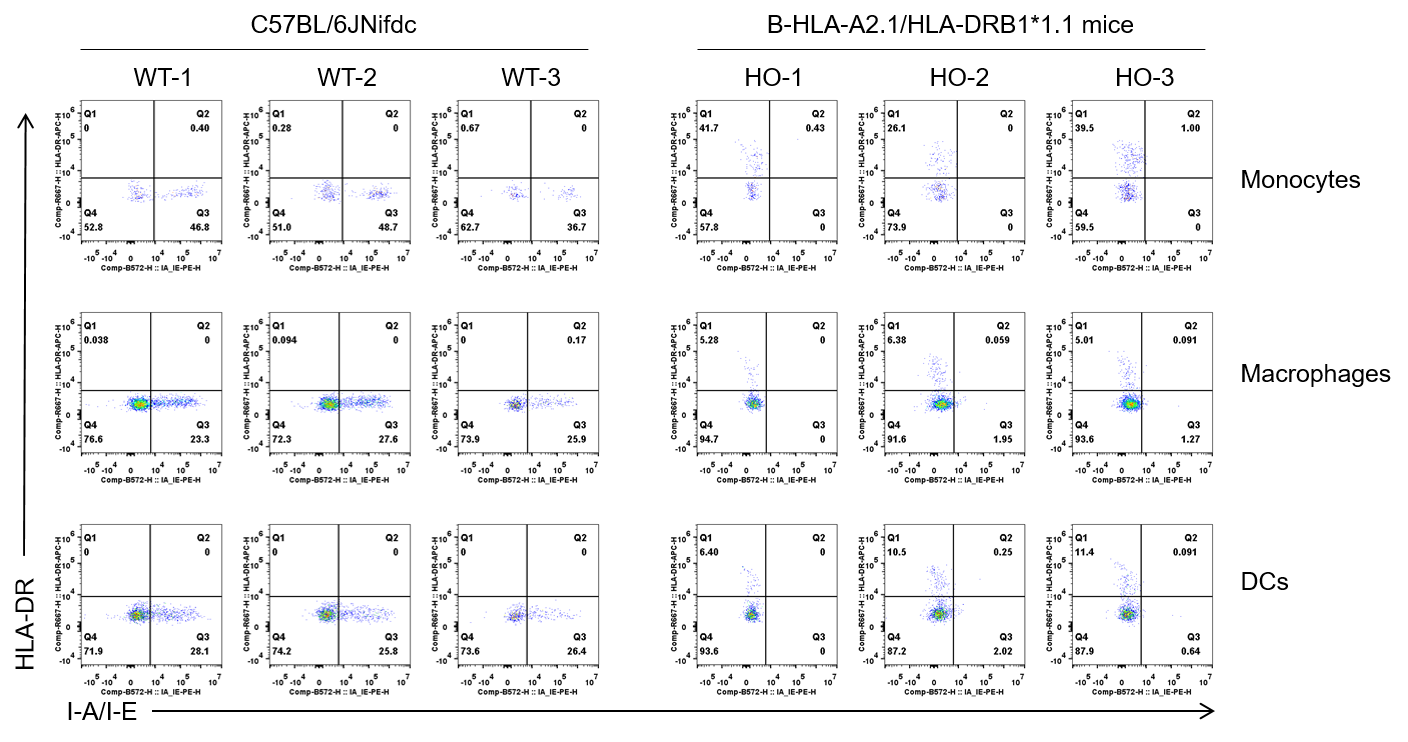
Strain specific HLA-DRB1 expression analysis in wild-type (WT) C57BL/6JNifdc mice and homozygous (HO) B-HLA-A2.1/HLA-DRB1*1.1 mice by flow cytometry. Blood cells were collected from wild-type C57BL/6JNifdc (+/+) and homozygous humanized B-HLA-A2.1/HLA-DRB1*1.1 mice, respectively, and analyzed by flow cytometry with species-specific anti-mouse I-A/I-E antibody (Biolegend, 107607), and species-specific anti-human HLA-DR antibody (Biolegend, 307610). Human HLA-DRB1 was exclusively detectable in homozygous B-HLA-A2.1/HLA-DRB1*1.1 mice, but not in wild-type C57BL/6JNifdc mice.

Strain specific HLA-DRB1 expression analysis in wild-type (WT) C57BL/6JNifdc mice and homozygous (HO) B-HLA-A2.1/HLA-DRB1*1.1 mice by flow cytometry. Blood cells were collected from wild-type C57BL/6JNifdc (+/+) and homozygous humanized B-HLA-A2.1/HLA-DRB1*1.1 mice, respectively, and analyzed by flow cytometry with species-specific anti-mouse I-A/I-E antibody (Biolegend, 107607), and species-specific anti-human HLA-DR antibody (Biolegend, 307610). Human HLA-DRB1 was exclusively detectable in homozygous B-HLA-A2.1/HLA-DRB1*1.1 mice, but not in wild-type C57BL/6JNifdc mice.

Strain specific HLA-DRB1 expression analysis in wild-type (WT) C57BL/6JNifdc mice and homozygous (HO) B-HLA-A2.1/HLA-DRB1*1.1 mice by flow cytometry. Bone marrow cells were collected from wild-type C57BL/6JNifdc (+/+) and homozygous humanized B-HLA-A2.1/HLA-DRB1*1.1 mice, respectively, and analyzed by flow cytometry with species-specific anti-mouse I-A/I-E antibody (Biolegend, 107607), and species-specific anti-human HLA-DR antibody (Biolegend, 307610). Human HLA-DRB1 was exclusively detectable in homozygous B-HLA-A2.1/HLA-DRB1*1.1 mice, but not in wild-type C57BL/6JNifdc mice.
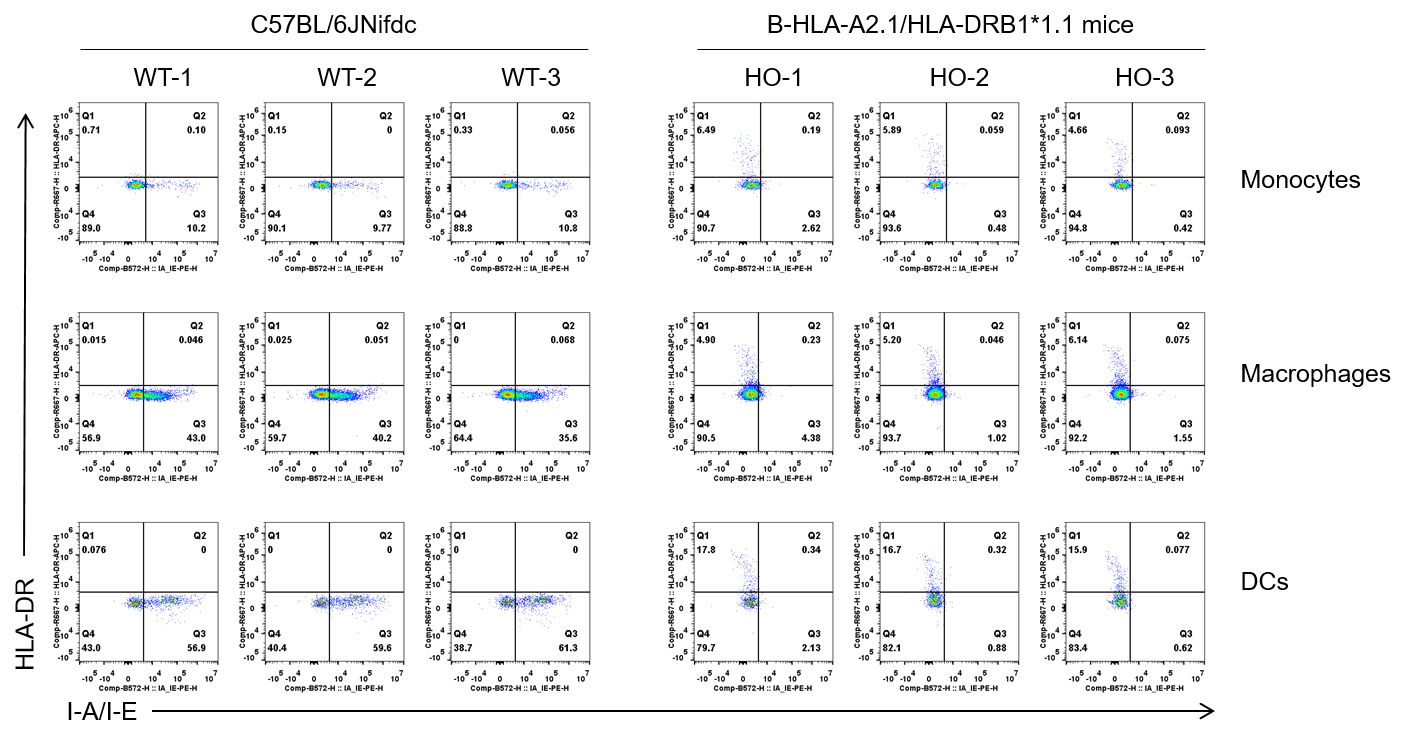
Strain specific HLA-DRB1 expression analysis in wild-type (WT) C57BL/6JNifdc mice and homozygous (HO) B-HLA-A2.1/HLA-DRB1*1.1 mice by flow cytometry. Bone marrow cells were collected from wild-type C57BL/6JNifdc (+/+) and homozygous humanized B-HLA-A2.1/HLA-DRB1*1.1 mice, respectively, and analyzed by flow cytometry with species-specific anti-mouse I-A/I-E antibody (Biolegend, 107607), and species-specific anti-human HLA-DR antibody (Biolegend, 307610). Human HLA-DRB1 was exclusively detectable in homozygous B-HLA-A2.1/HLA-DRB1*1.1 mice, but not in wild-type C57BL/6JNifdc mice.

Strain specific HLA-DRB1 expression analysis in wild-type (WT) C57BL/6JNifdc mice and homozygous (HO) B-HLA-A2.1/HLA-DRB1*1.1 mice by flow cytometry. Bone Marrow cells were collected from wild-type C57BL/6JNifdc (+/+) and homozygous humanized B-HLA-A2.1/HLA-DRB1*1.1 mice, respectively, and analyzed by flow cytometry with species-specific anti-mouse I-A/I-E antibody (Biolegend, 107607), and species-specific anti-human HLA-DR antibody (Biolegend, 307610). Human HLA-DRB1 was exclusively detectable in homozygous B-HLA-A2.1/HLA-DRB1*1.1 mice, but not in wild-type C57BL/6JNifdc mice.
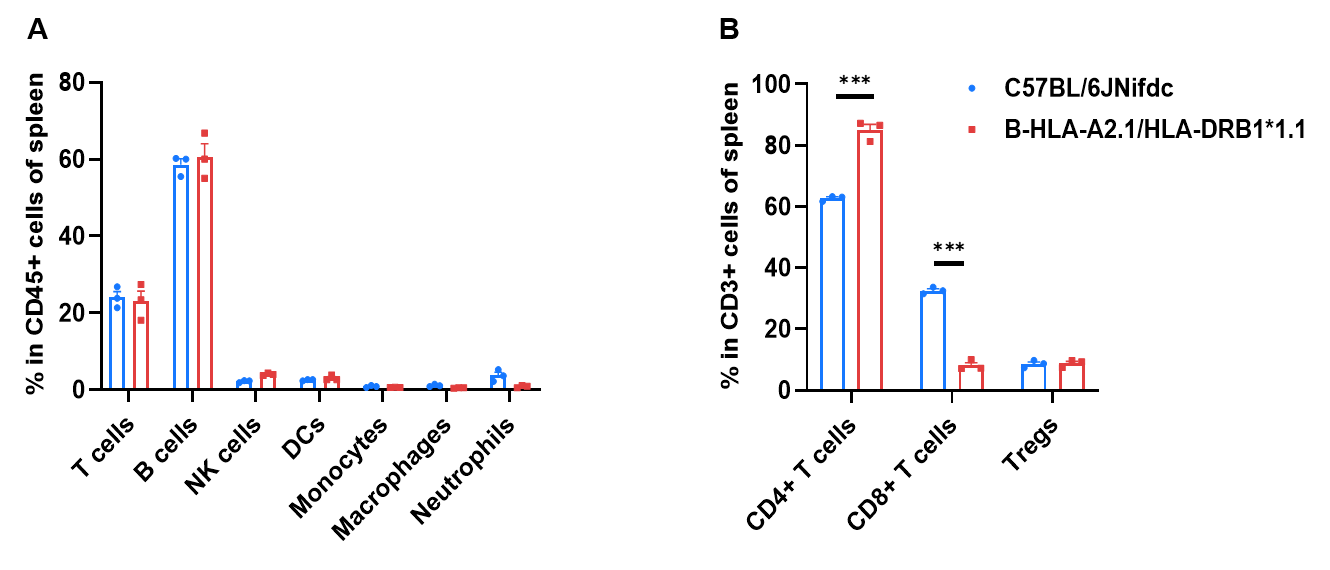
Frequency of leukocyte subpopulations in spleen by flow cytometry. Splenocytes were isolated from wild-type C57BL/6JNifdc mice and homozygous B-HLA-A2.1/HLA-DRB1*1.1 mice (male, 8-week-old, n=3). A. Flow cytometry analysis of the splenocytes was performed to assess the frequency of leukocyte subpopulations. B. Frequency of T cell subpopulations. Frequencies of T cells, B cells, NK cells, dendritic cells, monocytes, macrophages, neutrophils and Tregs in B-HLA-A2.1/HLA-DRB1*1.1 mice were similar to those in C57BL/6JNifdc mice. The frequency of CD8+ T cells in B-HLA-A2.1/HLA-DRB1*1.1 mice were lower than that in C57BL/6JNifdc mice, whereas the frequency of CD4+ T cells in B-HLA-A2.1/HLA-DRB1*1.1 mice were higher than that in C57BL/6JNifdc mice. Values are expressed as mean ± SEM. Significance was determined by two-way ANOVA test. *P < 0.05, **P < 0.01, ***p < 0.0001.

Frequency of leukocyte subpopulations in blood by flow cytometry. Blood were isolated from wild-type C57BL/6JNifdc mice and homozygous B-HLA-A2.1/HLA-DRB1*1.1 mice (male, 8-week-old, n=3). A. Flow cytometry analysis of the blood was performed to assess the frequency of leukocyte subpopulations. B. Frequency of T cell subpopulations. Frequencies of T cells, NK cells, dendritic cells, monocytes, macrophages, and Tregs in B-HLA-A2.1/HLA-DRB1*1.1 mice were similar to those in C57BL/6JNifdc mice. The frequency of neutrophils in B-HLA-A2.1/HLA-DRB1*1.1 mice were lower than that in C57BL/6JNifdc mice, whereas the frequency of B cells in B-HLA-A2.1/HLA-DRB1*1.1 mice were higher than that in C57BL/6JNifdc mice. The frequency of CD8+ T cells in B-HLA-A2.1/HLA-DRB1*1.1 mice were lower than that in C57BL/6JNifdc mice, whereas the frequency of CD4+ T cells in B-HLA-A2.1/HLA-DRB1*1.1 mice were higher than that in C57BL/6JNifdc mice. Values are expressed as mean ± SEM. Significance was determined by two-way ANOVA test. *P < 0.05, **P < 0.01, ***p < 0.0001.
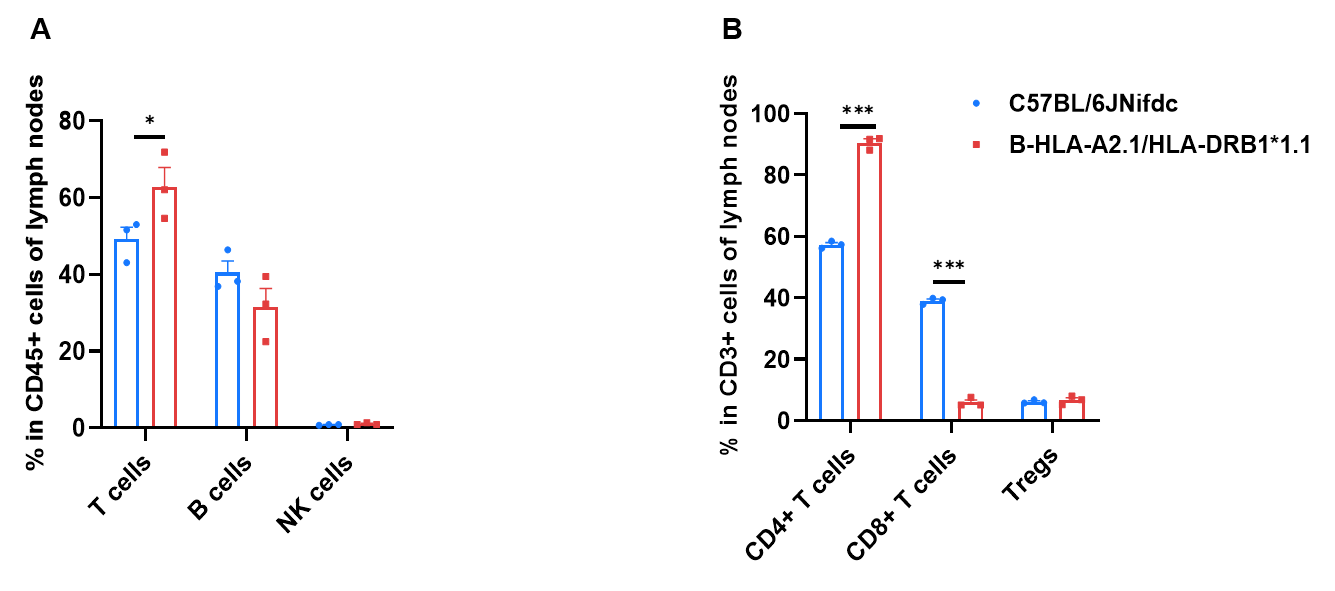
Frequency of leukocyte subpopulations in lymph node by flow cytometry. Lymph node cells were isolated from wild-type C57BL/6JNifdc mice and homozygous B-HLA-A2.1/HLA-DRB1*1.1 mice (male, 8-week-old, n=3). A. Flow cytometry analysis of the lymph node was performed to assess the frequency of leukocyte subpopulations. B. Frequency of T cell subpopulations. Frequencies of NK cells, and Tregs in B-HLA-A2.1/HLA-DRB1*1.1 mice were similar to those in C57BL/6JNifdc mice. The frequency of T cells in B-HLA-A2.1/HLA-DRB1*1.1 mice were higher than that in C57BL/6JNifdc mice. The frequency of CD8+ T cells in B-HLA-A2.1/HLA-DRB1*1.1 mice were lower than that in C57BL/6JNifdc mice, whereas the frequency of CD4+ T cells in B-HLA-A2.1/HLA-DRB1*1.1 mice were higher than that in C57BL/6JNifdc mice. Values are expressed as mean ± SEM. Significance was determined by two-way ANOVA test. *P < 0.05, **P < 0.01, ***p < 0.0001.

Antitumor activity of NY-ESO-1 mRNA vaccine against syngeneic tumors. (A) Experimental scheme. (B) Antitumor activity of therapeutic treatment with mRNA vaccine. B-HLA-A2.1/HLA-DRB1*1.1 mice (n=6/group) were vaccinated with PBS, LNP or LNP-mRNA. B-HLA-A2.1/HLA-DRB1*1.1 mice were implanted subcutaneously with 1×106 B-HLA-A2.1/hNY-ESO-1 MC38 tumor cells in the right flank and immunized four times at 1-week intervals with PBS, LNP or mRNA vaccines via intravenous (i.v.) injection on days 0, 7, 14 and 21 after tumor volume reached approximately 100 mm3. As shown in panel B, the mRNA vaccines demonstrated robust inhibition of tumor growth and significantly prolonged overall survival compared to the control group. C. Body weight changes during tumor growth observation. These results demonstrate that B-HLA-A2.1/HLA-DRB1*1.1 mice provide a powerful preclinical model for in vivo evaluation of mRNA vaccines. Values are expressed as mean ± SEM.